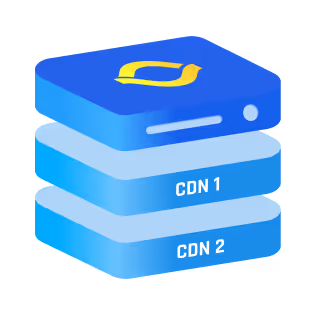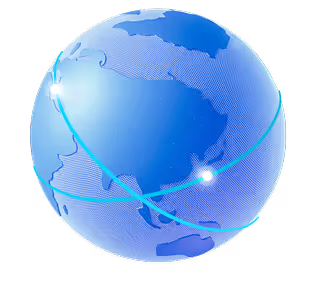Let’s say your website is hosted in New York, but a visitor from Tel Aviv opens it. Without edge caching, their browser has to reach all the way to your New York server to load the page. That’s like sending a letter across the world just to get a menu. Slow, right?
Edge caching solves this. It brings your content closer to the people using it—no matter where they are. But it’s not movie magic. In fact, the process is quite simple:
What Is Edge Caching?
Edge caching is the process of storing copies of your website’s content on servers that are physically closer to your users—these servers are called edge locations or network edge locations.
Instead of making a full trip to your origin server (where your actual site is hosted), the visitor’s browser pulls cached content from the nearest edge server. That might be in their own city, or at least in the same region. And just like that, your page loads way faster.
You’ve probably heard the term edge cache thrown around. That’s just the stored version of your content sitting on one of these edge servers.
Why Should You Care About Edge Caching?
Here’s the blunt truth: speed matters.
Slow sites lose visitors. People click away, bounce off, and sometimes never come back. Google also uses page speed as a ranking factor. So yeah, if you want people to stick around—and actually find your site in the first place—edge caching isn’t optional anymore.
With edge caching, you:
- Reduce page load time
- Cut down bandwidth usage
- Handle more traffic with less server stress
- Improve your SEO score
And the best part? You don’t need to rebuild your whole website to make it work.
{{cool-component}}
How Edge Caching Works
Imagine your origin server is a chef. Every time someone wants a burger (your web page), the chef has to make it from scratch. That’s fine if you’ve got one or two customers. But what if 10,000 people show up?
That’s where edge caching comes in.
Now imagine there’s a fridge next to the table. The chef makes one burger and puts copies in the fridge. The next people just grab it from there—same taste, way faster.
Here’s what’s actually happening behind the scenes:
- A user visits your website.
- If the content isn’t cached, it gets served from your origin and saved on a nearby edge server.
- The next visitor from that region gets the cached version instead—instant load.
The cache can include your images, scripts, HTML, CSS, and even full web pages. That’s why some folks call it web page caching. Because yeah, your whole site can be prepped and waiting at the edge.
How Edge Caching Works with a CDN
When you turn on a CDN (Content Delivery Network), it automatically starts caching your content at multiple network edge locations across the world. These are physical servers that are part of the CDN’s global network.
Let’s say someone visits your site from Mumbai. Instead of going all the way to your origin server in New York, the CDN checks if Mumbai’s edge location has a cached copy of the content. If it does, that user gets the cached version instantly—no delays, no long trips.
CDNs like Cloudflare, Akamai, or Fastly also let you fine-tune how this works. You can control:
- Which URLs should be cached
- How long the content stays cached (we’ll cover that)
- What to do when content changes
What Counts as a Network Edge Location?
These are physical data centers that exist all over the world, operated by CDNs (Content Delivery Networks) like Cloudflare, Akamai, or Fastly.
Think of them like mini-branches of your website, spread out globally. When someone visits your site, the CDN picks the closest network edge location and serves content from there. It’s almost like your site is everywhere at once.
Most modern CDNs have 100+ edge locations across continents. Some even have thousands. You don’t have to manage them. You just plug in the CDN, and it handles the rest.
{{cool-component}}
What Can Be Stored in an Edge Cache?
Good question. Not everything should be cached at the edge, but a lot can be. Here’s what usually goes in:
- Static assets (images, CSS, JS files)
- Full HTML pages (if they don’t change too often)
- API responses (with smart rules)
- Fonts and icons
Dynamic content (like a user’s private dashboard) usually skips the cache, unless you’re using modern CDNs. But even if it’s not present, you can mix and match—cache the static parts, load the private bits from the origin.
How Long Is Content Cached at the Edge?
The amount of time your content stays cached is controlled by a thing called TTL (Time To Live). It’s like an expiration date for the edge cache.
If you set a TTL of 1 hour, that means edge servers will store the content for an hour before checking your origin for updates. You can set it to minutes, hours, days—whatever fits your content.
Static stuff (like images, CSS, and blog posts) can have long TTLs—think hours or even days. Dynamic pages (like dashboards or personalized feeds) usually need shorter TTLs or no caching at all.
You can set these values using cache headers like:
Cache-Control: public, max-age=86400
Don’t want to deal with headers? Most CDNs let you control TTLs from a simple dashboard. You’re in full control either way.
Can You See What’s in Your Edge Cache?
Yup, many CDNs give you an edge cache viewer or a dashboard where you can peek into what’s being cached and where.
You’ll see:
- Which files are cached
- Hit/miss ratios (how often your cache is used vs. skipped)
- Which regions are hitting the edge cache the most
- When a file was last fetched from the origin
Some even let you purge specific URLs from the cache or set time-based rules. You’re not flying blind—you’ve got full visibility and control.
{{cool-component}}
What Happens During a Cache Miss?
A cache miss happens when the edge server doesn’t have a stored copy of the content. Maybe the content expired, was never cached, or was just purged.
When that happens:
- The request goes straight to your origin server
- The origin responds with fresh content
- That content gets saved in the edge cache for next time
So the first visitor pays the full trip cost (origin load), but every visitor after that gets the cached version—fast and efficient.
You’ll often see cache status headers like:
cf-cache-status: MISS
or
cf-cache-status: HIT
These help you debug and optimize. Tools like edge cache viewers and browser dev tools can help you spot which assets are missing from cache and why.
Common Misconceptions About Edge Caching
Let’s clear a few things up.
1. “It’s only for huge companies.”
Nope. Even a tiny blog with five visitors a day benefits from edge caching. Why? Because those five visitors will load your site faster. And Google will notice.
2. “It’s hard to set up.”
It’s not. Most web hosts or CDNs make it as simple as flipping a switch. Cloudflare, for instance, enables edge caching out of the box.
3. “Edge caching breaks my dynamic pages.”
Only if you cache them the wrong way. Most CDNs let you fine-tune caching rules, so you only cache what makes sense. Think blog posts, landing pages, media files—not your checkout cart.
When You Shouldn't Use Edge Caching
Edge caching isn’t a magic wand for everything. Some parts of your site should not be cached—because they change too often or they’re personal to the user.
Here’s when you should skip the cache:
- Logged-in user dashboards
(You don’t want someone else seeing your account info, right?) - Shopping carts or checkout pages
(These are dynamic and session-based) - Live data pages
(Like stock prices, real-time analytics, or live sports scores)
In these cases, serve the page directly from the origin, or use smart caching rules to separate static vs dynamic parts of the page. CDNs like Fastly and Cloudflare let you customize this at a very granular level.
What Happens When You Update Your Site?
Let’s say you change your homepage. If it’s cached at the edge, visitors might still see the old version… unless you tell the CDN to clear the cache.
This is called a “cache purge.” You can do it manually (via the CDN dashboard), set rules to expire after X minutes, or trigger it through your CMS or deployment process.
The idea is simple: whenever something changes, let your edge cache know so it doesn’t serve stale content.
A Quick Note on Edge Caching and SEO
Search engines love speed. When Google crawls your site and gets fast responses from edge locations, that’s a green flag.
Just make sure your cache doesn’t block crawlers from accessing updated versions of your content. Use cache-control headers wisely, and double-check your robots.txt if needed.
Bonus tip: Faster page loads = lower bounce rates = higher ranking potential. Edge caching isn’t just backend magic—it’s a front-row SEO move.
{{cool-component}}
Edge Caching vs Browser Caching vs Server-Side Caching
These are different layers of caching, and they all work together—but do different jobs.
Think of it like this:
- Browser cache is your user’s fridge
- Edge cache is the supermarket nearby
- Server-side cache is the warehouse that restocks everything
They all help reduce load and improve speed—but the edge cache is the one that helps globally, instantly.
Final Thoughts
If your website feels slow, clunky, or like it can’t handle even small traffic spikes, edge caching might be the most painless fix you’ve never tried.
It’s like handing out copies of your best work to people before they even ask—because it’s already there, at the network edge location closest to them.
Start small. Pick a CDN. Cache your static stuff. Watch how fast things feel. Then use your edge cache viewer to tweak and scale from there.
Trust me, your users—and your Google ranking—will thank you.



.png)
.png)
.png)






